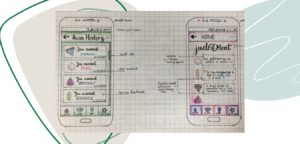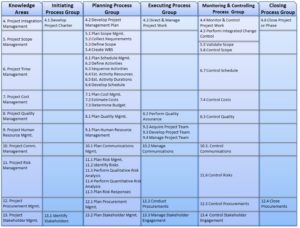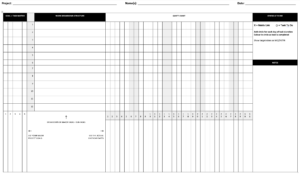Project Management in EE

To view the photo-rich magazine version, click here.
Originally appears in the Winter 2022 issue.
By John Negru
The future is uncertain, but we understand our children will face very different challenges than those of our generations. Indeed, many of those challenges will be the direct result of conditions our generations created. We are already seeing the environmental impacts of the climate crisis all around us; it is no longer just a theoretical debate.
The transformation of our society to a sustainable permaculture will require more than just good intentions. It will even require more than vision, faith, or love of nature. But since we can’t see the specifics of the journey ahead, we need to rely on a process we can trust to help us in navigating the unknown.
Fortunately, project management is already that well-defined process with much to offer. It is integral to every large undertaking that unfolds over time. Project managers work in every industry, from healthcare to construction to information technology and beyond. Even for people who are not professional project managers, project management is a very valuable life skill!
For all these reasons, teaching project-management skills is now a mission-critical aspect of education for tomorrow’s environmental activists. This article is about teaching project management to high school students.
My experience teaching project management
When I became a Technological Education teacher at age 50, I worked in a new school planned as a Specialist High Skills Major (SHSM) hub for Construction. As department head, I was responsible for planning the shops and labs, working with the architect on their build-out, procurement of equipment, development of curriculum, and so on. Our school was a beta site, so I was also involved in a variety of Board and Ministry of Education initiatives related to technological education.
As the school grew, I took on the role of teaching Technological Design courses. Grade 10 was focused on design process, product design, ideation, drafting, project management, and supply chain management. Grades 11 and 12 were focused on architectural design, construction technologies, building codes, urban planning, landscape architecture, geomatics, ideation and drafting, geographical information systems, and project management.
My Introduction to Land Surveying geomatics curriculum for Grades 11 and 12 was the first of its kind in Ontario. The Association of Ontario Land Surveyors asked me if I would create a version of the material that could be used freely by teachers everywhere. A brief brochure about the resource is available here: https://www.aols.org/site_files/content/pages/resources/shsm-publication-2017-low-res.pdf
With that in place, I worked with the Board Lead for Technological Education to create an Introduction to Land Surveying SHSM certification approved by the Ministry of Education, and I have delivered that program to a variety of school boards.
Aside from being a lot of fun for students, learning about surveying has many benefits. Not only is it integral to pretty much everything in the built environment; it gives students a practical application for the math they are learning, while showing them a great career path.
Once my geomatics program was underway, I turned to launching a similar program in project management, knowing its great value. My first step was to research the field, looking for the thought leaders and organizations who would give me the foundation for a PM curriculum.
After some trial and error with simplified approaches for students, I turned to the industry-standard, the Project Management Institute (PMI), whose practitioners are recognized globally as offering state-of-the-art expertise. I took a deep dive into the Project Management Body of Knowledge (PMBOK) and began adapting their approach for projects suitable for high school students.
The local chapter of PMI was extremely helpful in championing our cause. Their Project Management Institute Educational Foundation (https://pmief.org/) was another great source of ideas and resources.
At the same time, I wrote the Certified Associate in Project Management exam and received my CAPM designation, partly to demonstrate to my students how much I am committed to project management.
Back then (2016), project management was an approved certification for one Ontario Specialist High Skills Major program, in Non-profit. However, there was no project-management curriculum available to teachers, so the Project Management certification for Non-profit SHSMs existed in name only.
Again, with the help of our Board Lead for Technological Education and the local PMI chapter, I made the case to the Ontario Ministry of Education for Project Management to be a SHSM certification in all 19 SHSM programs and was successful in effecting that change.
Technological education is student-centred, project-based, activity-driven, and real-world-focused. Using PMI’s approach, I developed units for courses in Technological Design, Computer Engineering, and Communications Technology. Those were refined over the ensuing years, and I began evangelizing project management in larger educational forums.
A certification program
During the COVID-19 pandemic’s first and second waves, Ontario schools switched to online learning. In 2020 I was approached by the Ontario Council for Technological Education to create a fully online SHSM certification in Project Management, for implementation across the province. This was one of a variety of certifications created by OCTE in 2020 with funding from the Ontario government, and it has proved to be the most popular option among the range since its launch. A link to more information is here: https://www.octe.ca/en/shsm/online-learning
The online resource was quite different from my in-class material. It was focused more on exploring easily available, low-bandwidth YouTube resources covering the PMI approach, incorporating the five project-management process groups (Initiating, Planning, Executing, Monitoring and Controlling, and Closing), and the 10 knowledge areas (Integration, Scope, Schedule, Cost, Quality, Resources, Communications, Risk, Procurement, and Stakeholder Management). Assessment and evaluation of the students was based on a Google-Quiz format that tested their concept attainment. The entire certification was designed to be completed successfully and in a relatively stress-free way by individual students at home.

In the class, my focus was on providing students with a framework and a methodology for working with projects in specific courses. These projects were done in groups in units that ran over weeks, and in some cases more than a month. I’ll describe several such projects, as an example of how you could use this approach in your classes, but first a bit of context.
My project briefs to students were always very open-ended and kept to a textual minimum, with clear graphic cues to enhance comprehension, as well as a checklist of deliverables, due dates, and assessment criteria. The projects served as scaffolding for many types of learning. My pedagogical goal was to familiarize students with how to think like designers, employ a systems approach, and exercise strategic foresight.

The SCiO Project
In my Computer Engineering class, the technology focus was mobile spectrometry. It is frequently used for dry-matter analysis in agriculture (testing animal feed and silage for humidity, nutrient levels, etc., for example). Spectrometry has been around quite a while and is used extensively in assaying, materials quality control, and scientific research. The new mobile technology, Near Infra-Red Spectroscopy (NIRS) is revolutionary in that it offers on-site data capture, robust AI and data analytics, and cloud-based architecture. You can find out more about one application of the technology here: https://www.consumerphysics.com/
My idea was to have students create new NIRS applications, using the PMBOK approach. Rather than giving each group of three students detailed information, I instead gave them worksheets for each process group and knowledge area, showed them how the grids worked, and turned them loose to come up with their own new products as entrepreneurs. Having students present their products to others as a pitch to venture capitalists worked well. That is an approach often taken in post-secondary settings and in a variety of incubator intensives. It’s familiar to students from TV shows like Dragon’s Den and Shark Tank.
While the application of the technology would be specific to the course, the project-management learning would be entirely transferrable to any other project on which a student might be embarking.
What I found after some trial and error was that the entirety of project management was too much for students to take in without encroaching on the other learning outcomes the Ministry expected us to attain. The refined result hit all the key performance indicators, engaged the students, integrated a wide range of learning for them, and was easy for me to manage.
In my Technological Design courses, the projects ran the same way, but with differentiated deliverables. Here are three examples:
The Buttonville Airport Project
Buttonville was a regional airport in Toronto, slated to close and be redeveloped. Much of the planning process was opaque to the public. The project challenged the Grade 12 students to create an online public repository of information about the airport and the planning process. Here’s the result: https://buttonvilleredevelopment.wordpress.com/
Meanwhile, the Grade 11 students worked through a challenge to develop an environmentally beneficial mixed-use plan for the site.
The Richmond Green Park Project
Richmond Green is a large park in Richmond Hill, Ontario. Our school was adjacent to it. On the north side of the park was the largest undeveloped area in the municipality, more than 600 acres. It had been sold to a variety of developers who planned 2000+ new homes there. Of course, this would dramatically change the ecology of our park, including its flora and fauna. Furthermore, the park contained seven baseball diamonds in one of its quadrants, which were mostly idle.
Students were challenged to create new urban plans for the park that would involve rewilding the baseball diamonds, since those would be moved out into smaller neighbourhood parks in the new regional plan, accommodating new traffic access to the park and creating an eco-educational vision for visitors.
The project involved field trips, surveying, design charrettes, ideation, drafting, wayfinding design, and guest speakers, including a green-roof architect, urban planners, architects from a large developer showing their site plans, and so on.
We tried a similar project to design and build a vertical green wall on the school’s east face and to install solar panels on the roof, but were unsuccessful in obtaining Board support.
The Cabin Project
My Grade 12 Architectural Design students needed a project that would help them build a portfolio for post-secondary admissions. I challenged them to create designs for 500-square-foot off-the-grid cabins. Must-haves included minimal on-site electricity generation (solar, wind, or nano-hydro), passive solar heating and ventilation, a rocket stove, clean water collection and purification, active-solar water heating, a composting toilet, greywater management, and so on.
The deliverables were packaged in a design brief, including many aspects of project management, ideation sketches, AutoCAD site plans, elevations, floor plans to Code, and materials lists for procurement. Once I gave the students feedback on their briefs, each student built a 3D maquette of their design using materials of their choice. Photos of those, added to selections from the Design Briefs, gave students a fantastic portfolio for their post-secondary applications.
The Project-Management thread
Outdoor education and awakening ecological awareness can take many forms. Folks often tend to think of Green Teaching in terms of getting students outside for experiential learning in nature. Integrating projects like the ones discussed in this article into your courses allows you to bring the outdoors inside and break down the artificial barrier between the digital “in-here” aspect of our lives and the “out-there” aspect of the natural world. They also create a working model in your classroom that more closely resembles the real-world methodology students will encounter later in their journeys.
This approach also enables you to extend Green Teaching into other courses. For example, a Law course could be focused on environmental law and, using a project-management framework, involve developing a legal brief regarding something like protecting old-growth forests. A SHSM in Health and Wellness might include developing a forest-bathing field trip or educational resources on dangerous invertebrates such as ticks, and so on.
The key takeaway is that behind every attention point, there is a web of ecologically bound systems that touch all aspects of our lives. Teaching students how to see and work with those systems, to be strong change managers, and to have skills in both project management and strategic foresight are the underlying pedagogical drivers.
The nuts and bolts of project management
What follows is an extremely condensed introduction to project management. For a much more detailed insight into Project Management Process Group and Knowledge Area Mapping, start here: https://www.project-management-prepcast.com/pmbok-knowledge-areas-and-pmi-process-groups
A project is an activity with a defined goal and timeline. It has a beginning, middle, and end. The “owner” of a project is the person or team that has set the project charter. The project manager expands upon that charter with detailed plans about how to achieve the goal in the time allowed, with the available resources.
A project comprises five distinct processes:
Initiating
This process includes developing the project charter and identifying stakeholders.
Planning
This process includes developing the project-management plan; details on project scope; a Work Breakdown Schedule; overviews of cost, quality, human resources, communications, risk avoidance and mitigation; procurement; and stakeholder engagement.
Executing
Beyond directing and managing work, this process includes quality assurance, acquiring and managing the project team, communications, procurement, and stakeholder engagement.
Monitoring & Controlling
The key knowledge-area activities in here are tracking and directing work, scope validation, change management, and generally ensuring that all goes according to plan.
Closing
The project isn’t over until the paperwork is done. This can include activities around closing the project or phase, but it also includes closing procurements and documenting lessons learned.
Classroom application
If project management were easy, we wouldn’t need dedicated professionals and it would not be recognized as a career with certified practitioners. But that doesn’t mean we can’t impart the basics to students.
In each project, I would start by working with students to understand the project charter and identify stakeholders. Identifying the full range of stakeholders and classifying them was an interesting exercise for students, but not something they did easily. The goal was for each student group to come up with their project scope. In some cases, I also created Stakeholder Register and Communications Plan templates for students to complete.
The next step would be to do a needs assessment (gathering requirements in PMBOK-speak) of what stakeholders would require, deliverables, and key performance indicators. While it was valuable using that professional vocabulary with students, I often had to couch it in terms of technical specifications, features and benefits, and constraints and risks for context.
With this completed, students could create a Work Breakdown Structure. That could be on a Gantt chart. I also found the One Page Project Manager WBS template very useful: https://oppmi.com/ If I had to choose the most valuable aspect of project management for students, it was working with a WBS template, particularly around time management and KPIs.
There are also quite a few free apps now that can empower students to work together on projects, using real project-management tools. This is a great new development!
As a teacher, you understand that all of us are implicitly engaged in project management. What’s different here is that you are explicitly teaching the most widely recognized, highly transferrable, professional project-management skillset and telling the students that’s what you’re doing.
As Benjamin Franklin famously quipped, “If you fail to plan, you are planning to fail!” But we aren’t born with deep project-management skills; they’re taught. If we don’t teach them to our students, we are setting them up to fail. That’s not a viable response to the environmental risks they are already beginning to face.
John Negru is an actively retired Technological Education teacher, currently working for the Ottawa Carleton School Board. He also runs Canada’s leading independent Buddhist book publishing company, which offers a number of environmentally focused books. In addition, he is the author of six books and many feature articles for technical publications, as well as being an award-winning graphic designer. You can find out more about him here: https://www.linkedin.com/in/john-negru-b14a9713/










